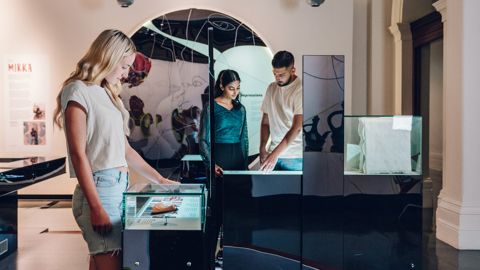Textile words and terms in India are often synonymous with the techniques used to create them. Batik, for example, refers to both the resist dyeing technique and the finished cloth. Many textiles take their names from their place of origin or the materials with which they were created.
Aari embroidery: the artisan uses a hooked needle or awl known as an aari to decorate the fabric with fine embroidery
Abhala bharat: mirrors or flat metal discs are couched onto the surface of a cloth. The practice is centred around Kutch, Gujarat
Ajrakh: resist and mordant block-printed cloth from the village of Ajrakhpur, Gujarat, made from kala cotton and featuring geometric patterns with hues of indigo, red, white and black. Its hallmark is double-sided printing, where the designs can be read from either side of the cloth
Alpana: Bengali folk art style painting
Appliqué: decorative needlework technique where cloth is sewn with pieces of cloth or ribbons
Ashavali: luxury brocade traditionally made of heavy silk and metallic thread, thought to date from around the 11th century. It is named after its place of origin, Ashaval, Gujarat (now Ahmedabad)
Bandha: ‘to bind’. Bandhani—‘the art of binding’—refers to tightly wrapping threads or cloth to prevent dye from reaching those areas when submerged in a dyebath. It is a form of tie dye associated mainly with Rajasthan and Gujarat
Batik: resist dyeing technique where hot wax is applied to the surface of a cloth before dyeing to limit the uptake of the dye
Bela: type of block printing usually specific to production of a style made in Kutch, Gujarat
Block printing: the use of carved wooden blocks to transfer dye or mordant to cloth, creating repeated patterns
Brocade: a supplementary weft weaving technique used to create sometimes elaborate motifs and patterns. Decorative threads are added while weaving in addition to those structurally integral to the cloth
Butta/Buta/Boteh: motifs, usually based on flowers, trees or mangoes with a curling tip, frequently found on Indian textiles; latter also known as paisley after the Scottish mill town Paisley, in Renfrewshire, which created mass-market imitations of Indian cloth from the late 18th century onwards
Catechu: brown dye extracted from Acacia trees
Cha Phulia: border made up of six lines of floating turtles and flowers associated with the town of Phulia, West Bengal
Chamba rumal: embroidered handkerchief traditionally involved in marriage ceremonies, usually a fine cotton muslin with silk threads. Associated with the historic Chamba State, which is now part of Himachal Pradesh, northern India
Chanderi: a fine cloth woven with gold threads and silk associated with the town of the same name in Madhya Pradesh
Charkha: portable spinning wheel associated with the Indian independence movement led by Gandhi
Chikankari/Chikan: embroidery or the art of embroidery, associated with the city of Nawabs in Lucknow, Uttar Pradesh
Chintz: generic term applied to Indian printed and painted cottons usually with floral or geometric designs. Often associated with those created for export
Clamp-dyeing: resist dyeing technique usually involving folding fabrics and securing them between wooden or metal clamps—these areas will not be exposed to dyestuffs; similar to tie dye techniques
Couching: embroidery technique where threads or other materials are attached to the surface of a cloth by building up multiple stitches. Often used with mirrors or other hard materials that cannot be pierced with a sewing needle
Cut Dana: embroidery technique involving the attachment of cut stones in patterns using couching stitches in combination with other stitches and decorative threads
Damask: method of weaving often intricate patterns into cloth using continuous weft, and often with the same-coloured warp and weft threads
Darshan-dwar phulkari: embroidery which honours the divine, usually created for used in shrines and temples. Darshan-dwar literally means ‘doorway to the divine’ and phulkari is a type of embroidery done in Punjab
Discontinuous weft/supplementary weft: additional threads that are not part of the structure of a cloth woven in to create patterns
Dupatta: shawl traditionally worn by women to cover the head and shoulders
Ek taar: untwisted single silk yarns used for embroidery, sometimes known as floss
Gota patti: technique involving the sewing of metallic ribbons onto the surface of a cloth which originated in Rajasthan
Gultarashi: cutting or shaving of rug pile at different lengths to create contours, often used to accentuate designs or to create patterns
Habotai: fine, plain-weave silk originally from Japan but now often originating in China
Himroo: hand-loomed fabric with a cotton base and silk weaving, with Persian heritage
Ikat: resist dyeing and weaving technique whereby bunches of threads are tie dyed, often several times, before they are woven, requiring great skill and calculation—the threads need to align in the weaving process for the patterns to make sense. Single ikat refers to a cloth where the threads of either the warp or the weft were dyed before weaving; double ikat refers to cloths where patterns were dyed into both the warp and the weft before weaving
Indigo: one of the world’s oldest dyes, resulting in a range of shades of blue, extracted from the leaves of certain plants from the Indigofera genus. The most commonly used is the species Indigofera tinctoria, unique in its ability to permanently dye both animal and vegetable fibres such as cotton without the use of mordants
Jaal: in the context of Indian textiles, it is a delicate lattice or net-like pattern
Jacquard loom: invented in France in the early 19th century, it was the first automated loom that could produce complex woven patterns in direct competition with hand-made Indian examples. The patterns were made using punch cards that were fed through the loom, causing particular warp threads to be lifted before the weft threads were passed through
Jamdani/Jamdan: weaving technique, traditionally used in Bengal, where different parts of the warp threads are manipulated independently in a supplementary weft technique, creating repeating patterns. The resulting cloth is usually very fine cotton muslin with geometric motifs.
Kaarigar: artisan or skilled maker
Kachha Kasab: embroidery, specifically involving couching of metallic threads onto the surface, usually in floral or geometric patterns
Kadhua/Kadwa: a supplementary weft weaving technique where each motif is woven separately, particular to Varanasi, Uttar Pradesh
Kairi: unripe or green mango
Kala Cotton: translates to black cotton—a cotton crop indigenous to India that relies on rainwater rather than resource-hungry irrigation, and is drought and pest resistant. Associated with Kutch, Gujarat
Kalamkari: hand-painted and hand-drawn cotton cloths created with natural dyes, associated with Andhra Pradesh. Kalam means ‘pen’; kari translates to ‘work’ or ‘the art of’
Kalka: Bangladeshi word for boteh or butta
Kamangiri: wall or fresco painting from Kutch, Gujarat
Kamdani/Mukaish/Badla: uses flat strips of silver inserted into the surface of the cloth, generally in combination with fine Chikankari embroidery to accent its patterns
Kani: type of very fine Kashmir shawl; also the wooden spools used to create the intricate weave associated with the ancient and protected technique similar to tapestry weaving or flatweave carpets
Kasavu mundu veshti: two-piece sari set (the sari, and an undergarment worn on the torso). Kasavu also refers to the gold or silver thread weaving technique of Kerala
Khadi: hand-spun, hand-woven cotton/silk/wool cloth that became synonymous with the struggle for Indian independence. Khadi was promoted by Gandhi as a means of self-sufficiency and its production was an act of defiance against the colonial rule of the British
Kora: raw, unprocessed cotton
Kota Doria: type of weaving with a checked pattern that takes its name from the village of Kota, Rajasthan. Created on traditional pit looms
Kotpad: a weaving and natural dyeing technique using dyes extracted from manjistha (madder root); synonymous with the village of the same name in Odisha
Kundalini: translates to ‘coiled snake’. In Hinduism, it is a form of divine feminine energy, located at the base of the spine. Rising of the Kundalini energy is associated with spiritual awakening
Lac: resin excreted by lac beetles used as a dyestuff to create pinks and light red colours
Maheshwari: type of cloth synonymous with the village of Mashewar, Madyha Pradesh. Usually silk or silk and cotton, and often woven with metallic threads
Mahtaab: Persian word meaning ‘full moon’ or ‘splendour of the moon’
Manjistha: Indian madder (Rubia cordifolia), used in natural dyeing to create rich reds and browns; used in conjunction with mordants to dye cotton reds and blacks
Marodi: embroidery using highly twisted gold thread, native to Gujarat
Mashru: heavy cloth, usually with a satin silk face and cotton base, created by using a cotton warp and silk weft. The weft threads are passed over more of the weft threads resulting in a face, or surface, that is predominantly made of the weft (silk), which means the reverse of the cloth is predominantly made of the warp threads (cotton)
Mata ni Pachedi: literally ‘behind the mother goddess’ in Gujarati language, a temple cloth depicting religious stories. It is created with kalamkari (hand-painting) using natural dyes in a tradition that dates back thousands of years
Meenakari: weaving technique in Varanasi where colours are added to the motifs, resembling encrusted jewels on fabric
Mochi: embroidery of Kutch and Saurashtra, famed for chain-stitch silk embroidery created using notched hooks or awls
Mordant: metallic oxide used to bind dyes to fibres
Muga: type of silk endemic to Assam, golden in colour and traditionally linked with royalty
Mulmul: muslin fabric of finely woven cotton plain traditionally associated with Bengal
Naba Kothi: textile depicts nine houses with nine auspicious motifs, woven in Odisha using tie and dye technique
Nakshi kantha: type of embroidered cover from Bengal created by quilting together several layers of repurposed soft, fine cotton saris in an early form of recycling
Paithani: variety of weave named after Paithan, Maharashtra, which involves tapestry-style weaving using vibrant silk yarns and golden thread
Parsi Gara: embroidered saris predominantly worn by women in the Parsi community for weddings and on special occasions, characterised by heavily embroidered motifs and traditionally with Chinese design influence
Patolu/Patola: cloth traditionally made using silk and single or double ikat technique, whereby the threads of either or both the warp and weft are dyed before they are woven in a traditional format featuring side and end borders, and a central field usually consisting of repeating motifs. Double ikat are woven in Patan, Gujarat, and single ikat in Rajkot, Gujarat.
Patwa work: silk tassel-making technique that originated in Rajasthan
Phulia khadi: hand-spun and hand-woven cotton from Phulia, West Bengal, known for its soft, fine weave. Khadi was promoted by Gandhi as a means of self-sufficiency and its production was an act of defiance against the colonial rule of the British
Phulkari: embroidery from Punjab, an area that straddles northwest India and eastern Pakistan. Characterised by fine darning embroidery covering most of the surface of a cloth
Pichwai: genre of hand-painted temple or sacred cloths devoted to the god Krishna, associated with the temple town of Nathdwara, Rajasthan
Rabari: ethnic minority people who originated in central Asia and settled in parts of Pakistan, Rajasthan and Gujarat in the 12th century, known for complex surface embellishment combining mirror work, chain stitch and running stitch, among others
Rangkaat: translates to ‘cutting colour’, a complex weaving technique of interlocking different hues of weft in a mosaic pattern using silk, and metallic threads. Associated with Varanasi, Uttar Pradesh
Resham: fine silk thread
Resist dyeing: range of techniques where areas of the surface of textiles, or threads used to create them, are treated or tied to prevent dye from reaching those areas, and thus creating designs
Saadi: saree, an unstitched garment draped by women in India
Sainchi phulkari: type of phulkari that depicts human and animal figures in narrative scenes of everyday life in rural Punjab; sainchi means ‘authentic’ in Punjabi
Sambalpuri bandha: a sari created using the double ikat technique, originating in the city of Sambalpur, Odisha
Shamilami: type of embroidery using animal motifs, associated with Manipur, eastern India
Supplementary weft/discontinuous weft: additional threads—not part of the structure of a cloth—woven in to create patterns
Tanchoi: translates to ‘touching the body’, it is a supplementary weft weave that renders a soft satin-like finish on the back of the fabric generally saris, woven in Varanasi, Uttar Pradesh
Tangaliya weaving: a Gujarati weaving technique made on pit looms, where knots are made at certain intervals in weft threads, to create small dots on the surface of the cloth. Associated with the Surendranagar district in the Saurashtra region of Gujarat
Telia Rumal: a headcloth or loincloth created with double ikat, originally from Andhra Pradesh, where traditionally the threads are treated with oil to soften them before dyeing and weaving
Thikri: small, hand-blown mirrors used to embellish the surface of Gujarati embroidery (Abhala bharat)
Tie dye: resist dyeing technique where threads are tightly bound around either other threads or a finished cloth to prevent the dyestuff from reaching those areas when it is submerged in a dyebath. Sometimes extends to the use of clamps and other devices to restrict the areas of cloth subject to the dye
Tussar silk: sometimes referred to as ‘wild silk’ as the silk cocoons are traditionally collected from trees growing in forests; prized for its golden colour
Vastra: general word for garment or clothing
Warp: threads strung tightly on a loom for weft threads to pass under and over
Weft: threads woven between warp threads to create the structure of cloth. Discontinuous or supplementary weft are additional threads that are not part of the structure of the cloth that are woven in to create patterns
Zardosi: heavy, ornate embroidery usually reserved for luxurious fabrics like silk or velvet, using metallic threads and sometimes precious stones, pearls and other ornaments
Zari: fine metallic threads used in embroidery or weaving







